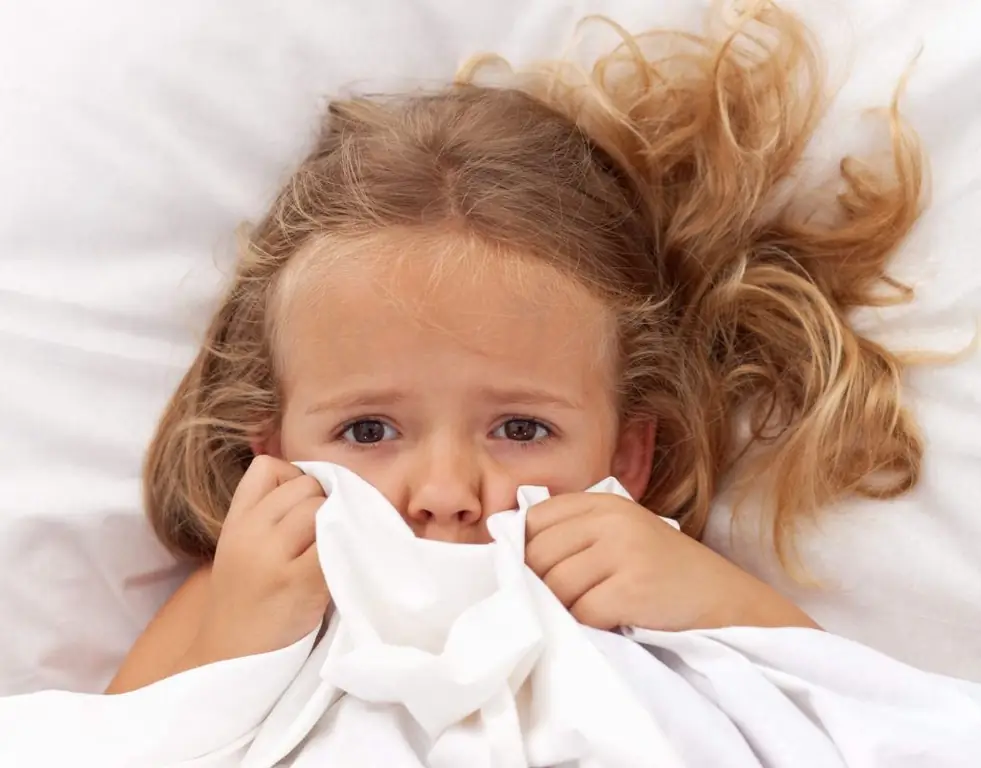2026 Author: Priscilla Miln | [email protected]. Last modified: 2025-01-22 17:55:26
A disease of the respiratory tract that results in stenosis of the larynx is called croup in medical science. This disease is accompanied by the following symptoms: noisy shortness of breath, hoarseness, "barking" cough, shortness of breath. Croup in a child is not uncommon. As a rule, it occurs against the background of various infectious diseases. In this article, we will take a closer look at the main issues regarding such a problem as croup in children.

Reasons
Very often mentioned disease develops in various infectious diseases such as measles, influenza, chicken pox, tuberculosis, typhoid fever, syphilis. Even a banal acute respiratory disease can provoke this pathology. Often, croup occurs as a complication of diphtheria. In some cases, simple herpes can cause the disease. In this case, along with swelling of the mucous membrane of the larynx and hyperemia, a rash may appear. First, these will be dotted papules, and then - erosion, covered with a yellow-white thin film. You should not discount such factors as unfavorable ecology, meteorological dependence, as well as weather conditions. Most often, the disease is diagnosed in children living in industrial (polluted) areas,as well as near polluted highways. An important role in the occurrence of pathology is played by a change in the reactivity of the child's body. The reason for this is various kinds of para- and malnutrition, encephalopathy, rickets, thymic-lymphatic status, exudative diathesis, pneumonia and neurological pathologies. Some children with croup have a history of drug or food allergies, sensitization, or asthma.
Who is at risk?
The most commonly diagnosed viral croup in children under three years of age. This is due to the anatomical and physiological structure of the respiratory system of babies. In children of this age group, the lumen of the larynx is much narrower, and the cartilage tissue is more pliable and tender than in an adult. The vocal cords are short. The submucosal layer consists of rather loose connective tissue. That is why, with inflammation of certain parts of the respiratory tract, edema often occurs, leading to a narrowing of the lumen of the larynx.
Pathogenesis

The larynx in the child's body performs voice-forming, respiratory and protective functions. Any narrowing of it can cause a violation of the patency of the upper respiratory tract, as well as oxygen starvation of vital organs (heart, brain, kidneys, etc.). Croup in a child is the result of inflammation. Ulcers, edema, necrosis, superficial erosion, damaging the mucosa, cause a reflex spasm of the muscles of the larynx. With stenosis, oxygen deficiency often develops, the mode of air ventilation of the upper sections is disturbed.respiratory tract. Then there is metabolic and respiratory acidosis, hypoxemia, cerebral edema. These disorders complicate the course of stenosis.
Croup in children: symptoms
The first signs of illness occur at night. Their appearance is due to anatomical and physiological factors: at this time, there is a high tone of the parasympathetic nervous system, in a horizontal position, as a rule, lung drainage worsens. Typically, croup in a child begins with a fever (up to 39 degrees).

He also gets a runny nose. Within twelve to forty-eight hours there is a "barking" rough cough, reminiscent of spitting. Often it is accompanied by increased respiration, retraction of the intercostal spaces, stridor. At the same time, during crying, the cough only intensifies. On examination, the doctor notes the narrowing of the larynx and trachea. This causes the appearance of the so-called noisy breathing, in which it is quite difficult for the baby to take a breath, as well as hoarseness and hoarseness. When exposed to cold and humid air, the symptoms are relieved.
Signs of diphtheria croup
The main symptom is a gradual increase in stenosis, leading to a steady progression of the severity of the condition. Characteristic signs are also "toxic" pallor of the skin, hoarse, and then silent cough. From the nose, due to paresis of the soft palate, fluid may flow. Croup in children, the symptoms of which are very unpleasant, is characterized by the formation of a gray-dirty coating on the tonsils. In this case, a putrefactive odor usually comes from the mouth. It should be noted that at night, a rapid deterioration in the condition is possible, leading to an extremely severe, up to a fatal outcome. Therefore, if alarming symptoms are detected, an ambulance should be called immediately.
Diagnosis

It is possible to identify an ailment, the main cause of which is viral diseases, in children using endoscopic methods. When examining the larynx, the mucous membrane looks swollen, hyperemic, easily injured. At the same time, edematous rollers are noticeable in the subglottic space. The contours of the bronchial and tracheal rings are smoothed. Mucopurulent exudate is in some cases scanty and liquid, but more often it is thick and viscous. Quite often fibrous and necrotic imposings are formed. After removal of plaque and casts, the lumen of the trachea becomes wide. However, its walls are a continuous bleeding wound. Inflammatory swelling of the mucosa leads to the fact that the mouths of the bronchi become slit-like, and sputum (purulent) emerges from the depths.
Tests
Today, the method of serological diagnosis of croup has acquired great importance. It is based on the use of sets of antibodies to certain viruses and bacteria. The PCR method (polymerase chain reaction) is also widely used. However, this method will be effective only if the biomaterial is taken from the oropharynx early (in the acute period). With the help of a blood test, non-specific inflammatory changes can be detected. So, with bacterial croup, leukocytosis is observed, with viral croup - leukopenia. For a more accurate diagnosis, as well as in case of suspicion ofthe occurrence of complications, X-ray methods are used (images of the cervical region, paranasal sinuses, chest, etc.). Another method is differential diagnosis. Here the main role is played by the clinical picture of the disease. The presence of previous diseases that can cause this complication is also taken into account.
Features of therapy

It is recommended to show the child to the doctor as soon as possible. Treatment of croup in children should primarily be aimed at relieving swelling of the airways. Today, hormonal preparations are used for these purposes. It is recommended to feed or water the baby as often as possible to avoid dehydration. You can bring down the temperature and relieve pain with ibuprofen or paracetamol. In this case, you must carefully read the instructions regarding the dosage or consult a doctor about this. You can also use antispasmodics, such as "Baralgin", "Maxigan", "Snazgan", etc. At the same time, it is recommended to give crumbs up to a year 1/3 of the tablet, and older children - 1/2. Decongestants and antitussive drugs will not help cure croup in a child, but they will greatly alleviate the condition of the baby. These are the first steps you can take before the doctor arrives. You should also ensure that cool fresh air enters the room.
Inpatient treatment
At the resuscitation stage, the focus is on restoring airway patency and combating toxicosis caused by an infectious disease. For thesepurposes, the method of nasotracheal intubation is used. Indications for its use are cardiovascular and respiratory failure caused by stenosis of the larynx 2, 3 and 4 degrees, as well as increasing hypoxia and hypercapnia.

Intubation is performed under general anesthesia. However, this method also has its drawbacks. First of all, these are postintubation chondroperichondritis of the trachea and larynx, leading to cicatricial stenosis. To prevent such complications, it is recommended to use special thermoplastic tubes. In addition, the treatment of croup in children is unthinkable without adequate antibiotic therapy, which is prescribed by a doctor, based on the individual characteristics of the baby. With this disease, as a rule, hormonal drugs are prescribed that contribute to the rapid relief of stenosis caused by a sharp swelling of the mucous membrane of the larynx. In some cases, patients are given glucocorticoid drugs. If in the first two hours after taking hormones their effectiveness is not found, further use of these drugs is not advisable. In the fight against toxicosis, infusion therapy is used.
Treatment of recurrent croup
In this disease, bronchodilators, mucolytics, etiotropic and anti-inflammatory drugs are used. Metered dose inhalers are effective. Particular attention should be paid to the elimination of edema that provokes spasms. Mucolytic drugs will help restore the normal functioning of the respiratory system. Secretolytics ("Ambroxol" and "Bromhexine") contribute toliquefaction of sputum, stimulate the formation of surfactant in the lungs. As

Anti-inflammatory drug, usually cromolyn preparations are used. After stopping the acute manifestations of croup, in order to prevent hypersensitivity of the bronchi and larynx, it is necessary to conduct a long-term (about two months) therapy with H1 receptor blockers (the drug "Cetirizine"). During the period of convalescence, immunostimulating drugs are prescribed. Their choice depends on the age of the child, the presence of an etiotropic pathogen, the prevalence of the inflammatory process. These drugs include "Bronchomunal" and interferon preparations. At the same time, the duration of treatment after discharge from the hospital should be at least one month.
Prophylaxis of croup
The main attention should be paid to hardening the child. You should often walk with the baby in the fresh air. This will help improve the functioning of the upper respiratory tract and strengthen the immune system. You can also do hardening of the throat. To do this, rinse it every day with cool water, gradually reducing the temperature of the liquid. However, in this case, do not rush. The adaptation process should take at least two months. In the final version, the water temperature is about 14-15 degrees. For older children, ice resorption can be used as hardening. Water is best frozen in a form with small cells, after mixing it with lemon juice. A child can be given one cube per day.

Prevention of viral diseases in children is to follow the principles of proper nutrition and the use of vitamins. This will help strengthen the body's defenses and will contribute to the proper and he althy development of the baby. It is very useful to eat fresh vegetables and fruits, drink herbal teas and decoctions. They will not only strengthen the immune system, but also help in the fight against early infections and viruses that have appeared. It is recommended to give your child foods rich in vitamins C and A. Fermented milk products are very he althy, especially live kefir.
It is important that the air in the apartment is warm and fresh. At the same time, a certain humidity must be maintained. Do not forget about the rules of hygiene. And smoking near the child is strictly prohibited. It is also not recommended to use scented oils, candles, etc. in the room where the baby is located. They can cause serious respiratory irritation.
Recommended:
The child does not want to communicate with children: causes, symptoms, character types, psychological comfort, consultations and advice from a child psychologist

All caring and loving parents will worry about the isolation of their baby. And not in vain. The fact that a child does not want to communicate with children can be a sign of a serious problem that will affect the formation of his personality and character in the future. Therefore, it is necessary to understand the reasons that force the baby to reject communication with peers
Schizophrenia in a child: signs and symptoms. Methods of treatment and diagnostics

Schizophrenia is an unhe althy mental state. This is a disease that can appear in childhood
Placenta accreta: symptoms, causes, diagnostic methods, possible risks for mother and child, treatment methods and recommendations from gynecologists

The placenta is an embryonic organ that allows the fetus to receive oxygen and nutrition during pregnancy. In the normal state of the woman and the correct course of pregnancy, the placenta is attached at the top of the uterus and remains there until the very time of childbirth. After the birth of a child, it exfoliates from the wall of the uterus and comes out
Night fears in a child: causes, symptoms, consultation with a psychologist and pediatrician, treatment and prevention of repeated fears

Night fears in a child are classified by experts as a widespread group of sleep disorders. Many parents have encountered their manifestation in their baby at least once in their lives. Most of all, children are afraid of bad dreams, darkness, the absence of their mother, and loneliness
Toxocariasis in children. Treatment of toxocariasis in children. Toxocariasis: symptoms, treatment

Toxocariasis is a disease about which, despite its widespread distribution, practitioners know not so much. The symptoms of the disease are very diverse, so specialists from various fields can face it: pediatricians, hematologists, therapists, oculists, neuropathologists, gastroenterologists, dermatologists and many others

